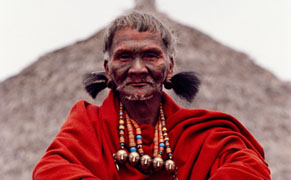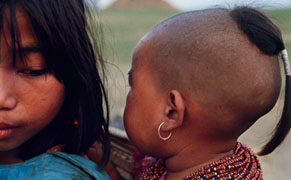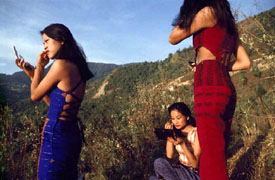 |
| "Nagas:
Hill people of India." Photo by Pablo Bartholomew. |
Strictly dedicated to Himalayan Art, the Rubin Museum of Art
presents "Nagas: Hill People of India" through September
21, 2009. The Indian photographer Pablo Bartholomew explores the
Nagas civilization, a people between tradition and transition.
Nagas people live in tribes in the Northeast of India, in the
low hills of Himalaya. Pablo Bartholomew's photographs show their
daily life, their cultural shocks, and the difficulty they have
in conserving a traditional culture while confronting western
and modern cultural influences.
Pablo Bartholomew, an Indian photojournalist, is based in New
Delhi. Especially interested in photographing his country and
its population, he won in 1975 the World Press Photo's first prize
for his series on Morphine Addicts in India.
 |
| "Nagas:
Hill people of India." Photo by Pablo Bartholomew. |
Inspired by his father, a photographer himself, Bartholomew started
photographing very young, and immortalized the India of the 70s.
Now a world renowned 55 year old photographer, he has been inspired
by the Nagas culture since his youth. This photographic collection
presented at the Rubin Museum of Art was shot over the past 10
years, throughout different trips and expeditions in the low hills
of the Nagas people. Bartholomew tries to understand their culture,
to analyze their daily life and their rites. Throughout this work,
we learn a lot about a people torn between two worlds, between
prehistoric practices and the discovery of 21st century habits.
You can listen to a very interesting interview with the artist
on those subjects at the exhibit.
On the way, you will have the chance to discover the Rubin Museum
and its permanent collection. The museum was created in 1999 and
is strictly dedicated to the arts of the Himalayan area (Tibet,
India, Nepal, Pakistan). It is the perfect place to learn about
the art of this region.
 |
| "Nagas:
Hill people of India." Photo by Pablo Bartholomew. |
The museum owns a magnificent collection of Buddhist statuettes
and Tibetan textiles from the XII century. You will also learn
a lot about the meaning of Himalayan Art and on the different
deities of Buddhism. The informative plaques explaining the exhibits
to visitors are particularly well done, and make pieces easily
understandable. Note that access to the museum is free to all
on Friday nights (7-10PM). The food is not free, but why not take
the occasion to enjoy the Asian tapas menu and some cocktails
at the charming museum cafe?
One feels a very special energy in this the place. I assure to
you that you will leave calm, peaceful and removed from New York's
agitation. [Suzanne Trouve Feff]